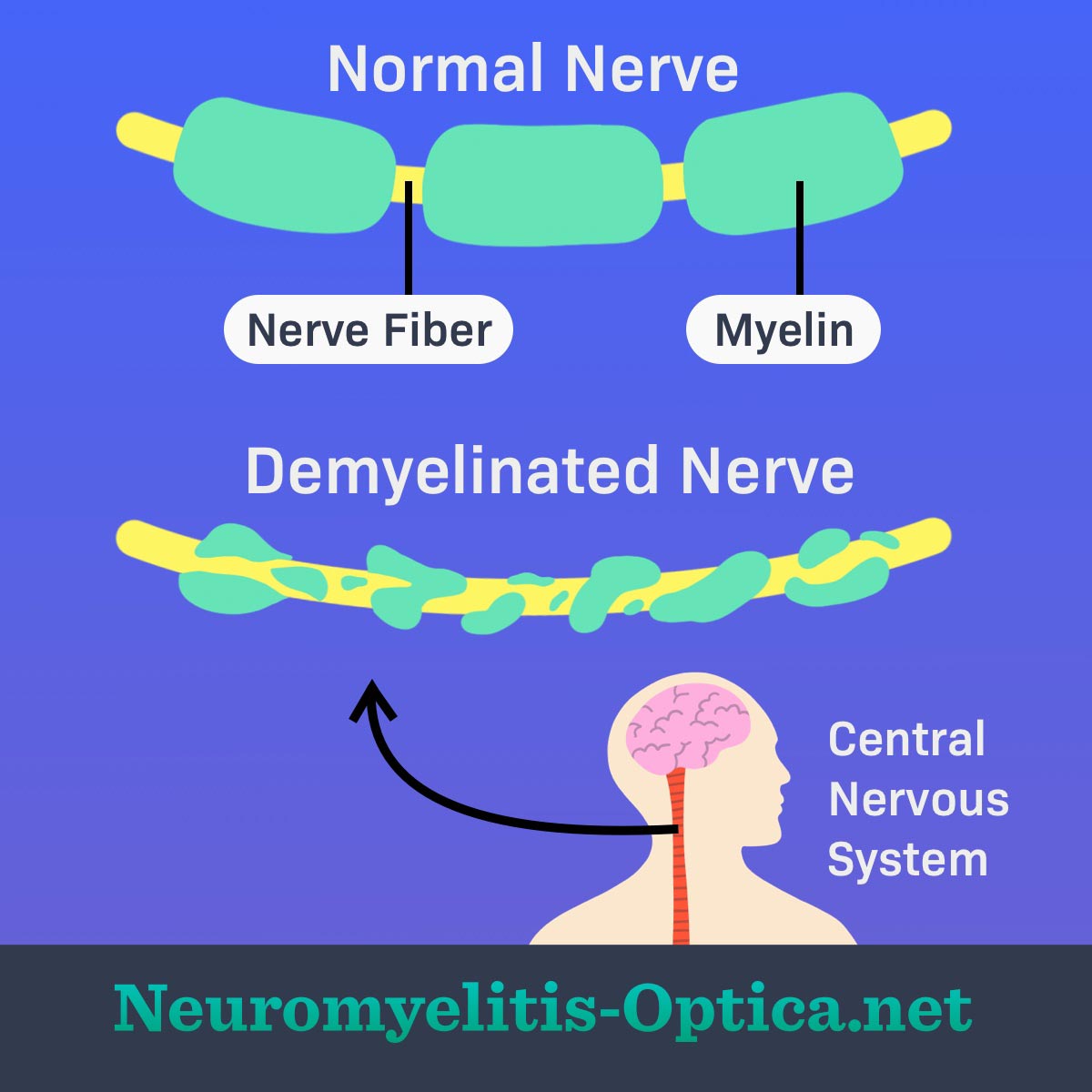Walking Issues and Paralysis
Reviewed by: HU Medical Review Board | Last reviewed: September 2021 | Last updated: March 2024
Neuromyelitis optica spectrum disorder (NMO) is a chronic disorder that impacts the central nervous system (brain, spine, and nerves of the eye). NMO classically causes swelling (inflammation) of the optic nerve (optic neuritis) or spinal cord (transverse myelitis). This inflammation occurs in episodes that last for days or weeks, then can improve or resolve. Sometimes, lasting weakness, blindness, or paralysis occurs. Balance problems muscle weakness, paralysis, and spasticity can all result from NMO and may impact the lives of those living with the disease.1
What causes muscle weakness and paralysis with NMO?
Nerve fibers in your brain, spinal cord, and eye have a protective coating called myelin. When this coating is damaged, it is called demyelination. NMO, like some other diseases, is a demyelinating disease, because it attacks the myelin coating on nerve fibers.2
When myelin is damaged, nerve signals can slow or stop. In the spinal cord, damaged myelin leads to a condition called transverse myelitis.2,3
Figure 1. Demyelination Graphic
What is transverse myelitis?
Transverse myelitis occurs when inflammation damages the spinal cord. You may sometimes hear transverse myelitis referred to as “spinal cord lesions” by your doctor. Transverse myelitis can cause muscle weakness, paralysis, or pain. It may also lead to bladder and bowel problems.3,4
A squeezing sensation often accompanies transverse myelitis, usually felt across the middle of the belly.4
Muscle symptoms of transverse myelitis include:4
- Weakness of the arms and legs – Those with inflammation of the upper spinal cord may have arm weakness. Muscle weakness from transverse myelitis usually progresses quickly. Weakness in the arms or legs can lead to partial or total paralysis. Weakness and paralysis as a result of an NMO attack may or may not be permanent.
- Sensation problems – Inflammation and damage to the spinal cord can lead to abnormal sensations, such as:
- Numbness
- Tingling
- Pins and needles
- Coldness
- Burning
Spasticity and NMO
Paroxysmal tonic spasms (PTS) are painful muscle spasms that happen as a result of the nerve damage caused by NMO. These intensely painful spasms can last seconds to minutes and can happen multiple times a day. PTS has been reported to impact 25 to 40 percent of those with NMO.5,6
Mobility problems and muscle symptoms
Loss of balance, muscle weakness, paralysis, and spasticity can all lead to issues with walking or mobility in NMO. These can greatly impact your daily activities and your ability to maintain your independence. Tell your doctor about any concerns you may have about your mobility, even if you think they may be minor.7
How are problems related to muscles diagnosed?
Your neurologist will perform a detailed brain and nerve exam (neurological exam). This is a nervous system exam that checks a wide variety of functions, such as:8
- Memory and thinking
- Function of cranial nerves (nerves in the brain stem that control many parts of the body)
- Muscle strength, reflexes, and movement
- Sensations
- Coordination, balance, and walking
The doctor will use different types of instruments, like a reflex hammer to test reflexes or a tuning fork to test sensation. Different tests can determine whether transverse myelitis is the cause of the muscle problems in addition to ruling out other disorders. These tests may include:4,9,10
- Magnetic resonance imaging (MRI) – MRI imaging uses magnetic fields to produce 3D renderings of the tissues, including the brain and spinal cord.
- Blood tests – These are used to rule out various disorders. Tests that search for AQP4 (AQP4-IgG) and MOG (MOG-IgG) antibodies in the blood are often used because these harmful antibodies are commonly found in those with NMO and may also be used to diagnose NMO.
- Lumbar puncture – This procedure is also known as a spinal tap. A lumbar puncture can be done inside or outside of the hospital. It involves inserting a needle through the back and into the space around the spinal nerves. A small sample of cerebrospinal fluid (CSF) is collected. CSF is a colorless fluid produced in the brain. It surrounds the brain and spinal cord to provide cushioning and important nutrients. Those with transverse myelitis may have increased protein levels and more white blood cells in their CSF.
Treatment
Treatment for balance, muscle weakness, paralysis, and spasticity in NMO involve treating the cause and managing the symptoms. Treatment options include:4,5,7,11,12
- IV steroid drugs – These strong anti-inflammatory drugs decrease inflammation and swelling in the spinal cord, which treats transverse myelitis.
- Plasma exchange (plasmapheresis) – Plasma exchange is when a machine removes the abnormal antibodies in your blood plasma and replaces it with healthy plasma. In NMO, harmful antibodies can cause damage to the nerves in the spine and brain. This damage can lead to balance and muscle problems. Removing these harmful antibodies helps treat the balance and muscle problems caused by NMO.
- Other drugs or therapies – Your doctor may suggest other drugs or therapies, based on your physical exam and symptoms.
- Physical and occupational therapy – These therapies may help you move your body and improve your activities of daily living.
- Mobility devices – The muscle effects of NMO can sometimes make previously simple, daily tasks harder to do. Mobility devices are available that can help you to regain your independence. Some of these may include:
- Wheelchairs
- Crutches
- Walkers
- Canes
